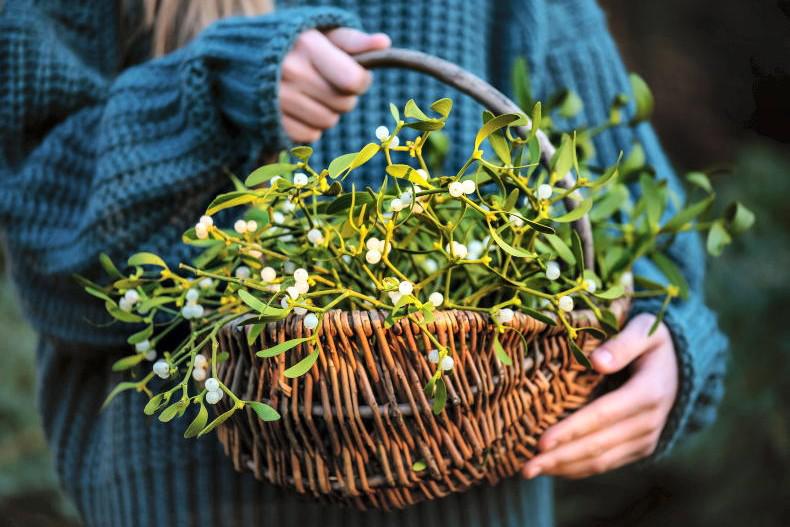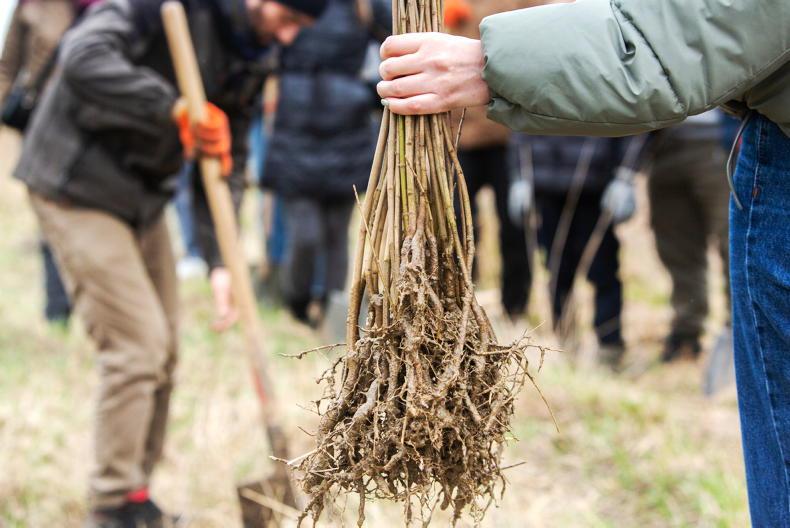As October arrives, the days grow discernibly shorter and temperatures begin to drop. Yet, we remain hopeful that mother nature will bestow some dry, cold and calm days upon us which are ideal for clearing and covering garden beds as they steadily empty.
October also brings a sense of optimism as we bask in the beauty of autumn’s colours and begin planting hardy, overwintering crops that will be ready to reap next year.
Overwintering garlic
Garlic enjoys a long growing season and from now right up to January is a good time for planting. An old wives tale suggests that garlic grows best when planted on the shortest day of the year but I like to get mine in the ground in October when the soil is workable.
Garlic makes a great follow on crop at this time of year, enjoys fertile well drained soil and grows best in full sun. Prepare the soil by removing weeds, broadforking if compact.
Compost can be surface layered after planting. Using a dibber, plant virus free cloves of garlic at about twice their own depth, pointed end up. They can be planted in blocks, 25cm x 25cm apart or allow 30cm in the row and plant bulbs 15cm apart.
If you have surplus cloves, you can imitate the Chinese and grow them at close spacing (3cm each way). Harvest these as single clove green shoots for use in their entirety early next year.
Overwintering onions
Onions are another crop that can be overwintered with suitable sets such as ‘Radar’ available to buy now. These autumn planted onions will grow slowly over winter, bulk up next spring and produce onions six to eight weeks before spring planted sets are ready in July and August.
Also referred to as Japanese onions, these overwinterers come with the added advantage that their green leaves remain intact and taste delicious.
Prepare the surface layer with compost and individually sow sets in rows 25/30cm apart, allowing 10-15cm between each set. Ensure tips are showing above ground but beware of meddlesome birds. It pays to cover the bed with a fleece until they have rooted.
It’s helpful to know that growing onions through black fleece or fabric will aid soil protection whilst reducing weed competition.
Harvest squashes

Pumpkins and squash are late summer crops. \iStock
Pumpkins and squash are late summer crops so from about September, foliage will begin to lose vigour and colour and expose the coloured fruits. This year foliage tended to stay green for longer so there’s a chance you are only ready to harvest your squashes now.
Skin should be firm, rich coloured and hard and the stems dry and starting to crack when harvesting. Skins will change colour during the curing and storage stage, changing from green to orange.
To harvest, use sharp pruners or a knife to cut the fruits from the vine, leaving a few inches of stem attached. This will help prolong their shelf life and prevent rot. Place fruits in a sunny dry spot – a conservatory or tunnel is perfect – to allow skins to cure before storage.
Transfer to a cool, dry shed with good air circulation after about two weeks where they will then keep for several months. Check stored squashes regularly and aim to use the bulk of your store before Christmas as they do tend to lose condition thereafter.
Good to note that all squash seeds are edible but you need to be mindful if you intend to save seed as different cultivars of the same species will cross.
Sow overwinter broad beans
Broad beans are a hardy crop that are well adapted to growing over winter and well worth a try if space allows.
Super Aquadulce and Aquadulce are two of the most reliable overwinter varieties and respond well to module and direct sowing, the latter being the most straightforward as seeds are large and easy to handle.
Direct sow broad beans approximately 5cm deep in a drill, allowing 10-15cm between plants and 60cm between rows. It always pays to sow spares at the end of a row to fill gaps in case of failure. Sowing extras in modules is also useful.
If you are growing in wet or heavy clay soil conditions or have a site prone to rodents and other furry foragers, starting off seeds in pots for later transplanting will be your only option.
Overwinter varieties will certainly benefit from shelter and well-drained soil and should be sown from late October to early November. Hold back sowings until then as otherwise plants will be too advanced and more susceptible to frost and harsh weather.
Overwintering broad beans may not thrive in all climates or soil types, but they are worth a try.
Crops grow slowly over winter but generally jump after the spring equinox and provide a delicious early crop by the following June.
As October arrives, the days grow discernibly shorter and temperatures begin to drop. Yet, we remain hopeful that mother nature will bestow some dry, cold and calm days upon us which are ideal for clearing and covering garden beds as they steadily empty.
October also brings a sense of optimism as we bask in the beauty of autumn’s colours and begin planting hardy, overwintering crops that will be ready to reap next year.
Overwintering garlic
Garlic enjoys a long growing season and from now right up to January is a good time for planting. An old wives tale suggests that garlic grows best when planted on the shortest day of the year but I like to get mine in the ground in October when the soil is workable.
Garlic makes a great follow on crop at this time of year, enjoys fertile well drained soil and grows best in full sun. Prepare the soil by removing weeds, broadforking if compact.
Compost can be surface layered after planting. Using a dibber, plant virus free cloves of garlic at about twice their own depth, pointed end up. They can be planted in blocks, 25cm x 25cm apart or allow 30cm in the row and plant bulbs 15cm apart.
If you have surplus cloves, you can imitate the Chinese and grow them at close spacing (3cm each way). Harvest these as single clove green shoots for use in their entirety early next year.
Overwintering onions
Onions are another crop that can be overwintered with suitable sets such as ‘Radar’ available to buy now. These autumn planted onions will grow slowly over winter, bulk up next spring and produce onions six to eight weeks before spring planted sets are ready in July and August.
Also referred to as Japanese onions, these overwinterers come with the added advantage that their green leaves remain intact and taste delicious.
Prepare the surface layer with compost and individually sow sets in rows 25/30cm apart, allowing 10-15cm between each set. Ensure tips are showing above ground but beware of meddlesome birds. It pays to cover the bed with a fleece until they have rooted.
It’s helpful to know that growing onions through black fleece or fabric will aid soil protection whilst reducing weed competition.
Harvest squashes

Pumpkins and squash are late summer crops. \iStock
Pumpkins and squash are late summer crops so from about September, foliage will begin to lose vigour and colour and expose the coloured fruits. This year foliage tended to stay green for longer so there’s a chance you are only ready to harvest your squashes now.
Skin should be firm, rich coloured and hard and the stems dry and starting to crack when harvesting. Skins will change colour during the curing and storage stage, changing from green to orange.
To harvest, use sharp pruners or a knife to cut the fruits from the vine, leaving a few inches of stem attached. This will help prolong their shelf life and prevent rot. Place fruits in a sunny dry spot – a conservatory or tunnel is perfect – to allow skins to cure before storage.
Transfer to a cool, dry shed with good air circulation after about two weeks where they will then keep for several months. Check stored squashes regularly and aim to use the bulk of your store before Christmas as they do tend to lose condition thereafter.
Good to note that all squash seeds are edible but you need to be mindful if you intend to save seed as different cultivars of the same species will cross.
Sow overwinter broad beans
Broad beans are a hardy crop that are well adapted to growing over winter and well worth a try if space allows.
Super Aquadulce and Aquadulce are two of the most reliable overwinter varieties and respond well to module and direct sowing, the latter being the most straightforward as seeds are large and easy to handle.
Direct sow broad beans approximately 5cm deep in a drill, allowing 10-15cm between plants and 60cm between rows. It always pays to sow spares at the end of a row to fill gaps in case of failure. Sowing extras in modules is also useful.
If you are growing in wet or heavy clay soil conditions or have a site prone to rodents and other furry foragers, starting off seeds in pots for later transplanting will be your only option.
Overwinter varieties will certainly benefit from shelter and well-drained soil and should be sown from late October to early November. Hold back sowings until then as otherwise plants will be too advanced and more susceptible to frost and harsh weather.
Overwintering broad beans may not thrive in all climates or soil types, but they are worth a try.
Crops grow slowly over winter but generally jump after the spring equinox and provide a delicious early crop by the following June.










SHARING OPTIONS